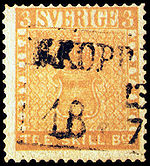 Traditional philately is the study of the technical aspects of stamp production and stamp identification, including:
Traditional philately is the study of the technical aspects of stamp production and stamp identification, including:* The initial stamp design process;
* The paper used (wove, laid, etc., and including watermarks);
* The method of printing (engraving, typography, etc.);
* The gum;
* The method of separation (perforation, rouletting);
* Any overprints on the stamp;
* Any security markings, underprints or perforated initials ("perfins"); and,
* The study of philatelic fakes and forgeries.
Thematic philately, also known as topical philately, is the study of what is depicted on the stamps. There are hundreds of popular subjects, such as birds on stamps, and ships, poets, presidents, monarchs, maps, aircraft, space craft, sports and insects on stamps. Interesting aspects of topical philately include design mistakes and alterations, for instance, the recent editing out of cigarettes from the pictures used for United States stamps, and the stories of how particular images came to be used.
Fig. 4. One of many covers flown on the Hindenburg Zeppelin, featuring a variety of postal markings.
Postal history concentrates on the use of stamps on mail. It includes the study of postmarks, post offices, postal authorities, postal rates and regulations and the process by which letters are moved from sender to recipient, including routes and choice of conveyance. A classic example is the Pony Express, which was the fastest way to send letters across the United States during the few months that it operated. Covers that can be proved to have been sent by the Pony Express are highly prized by collectors.
Aerophilately is the branch of Postal history that specializes in the study of airmail. Philatelists have observed the development of mail transport by air from its beginning, and all aspects of airmail services have been extensively studied and documented by specialists.
Postal stationery includes stamped envelopes, postal cards, letter sheets, aérogrammes (air letter sheets) and wrappers, most of which have an embossed or imprinted stamp or indicia indicating the prepayment of postage.
Cinderella philately is the study of objects that look like stamps, but aren't postal stamps. Examples include Easter Seals, Christmas Seals, propaganda labels, and so forth.
Philatelic literature documents the results of philatelic study and includes thousands of books and periodicals.
Revenue philately is the study of stamps used to collect taxes or fees on such things as, legal documents, court fees, receipts, tobacco, alcoholic drinks, drugs and medicines, playing cards, hunting licenses and newspapers.
Maximaphily is the study of Maximum Cards. Maximum Cards can be defined as a picture post card with postage stamp on the same theme and a cancellation, with a maximum concordance between all three.
This is a list of postage stamps that are especially notable in some way, often due to antiquity or a postage stamp error.
The best-known stamps:
Treskilling Yellow (Sweden)

Penny Black (Britain)

Bull's Eye (Brazil)

British Guiana 1c magenta

Mauritius "Post Office"

Inverted Jenny (United States)

Basel Dove (Switzerland)

Benjamin Franklin Z Grill (United States)


Custom Search
If you liked this article, subscribe to the feed by clickingthe image below to keep informed about new contents of the blog:
